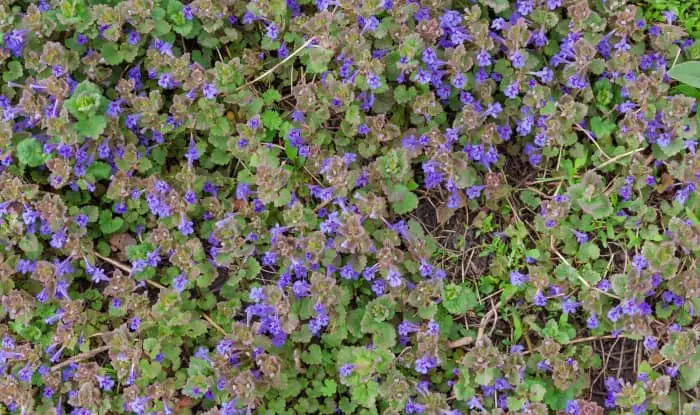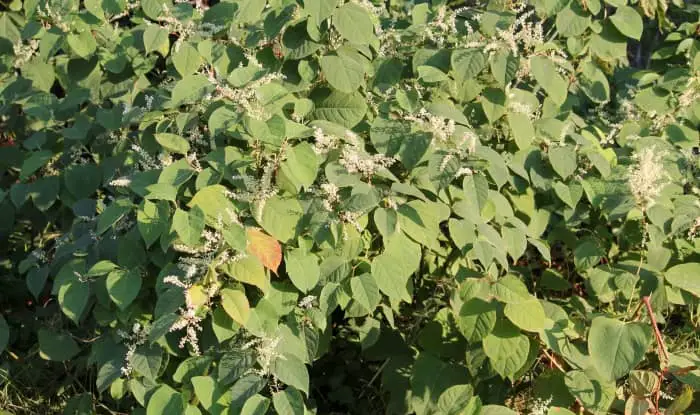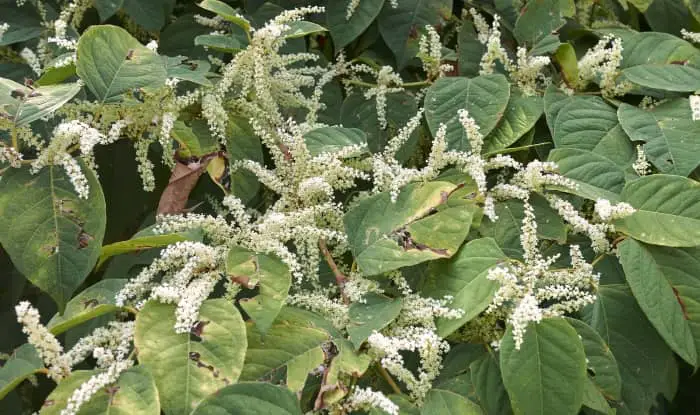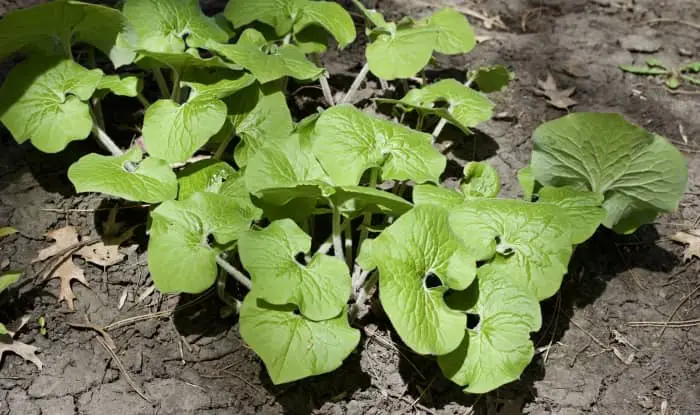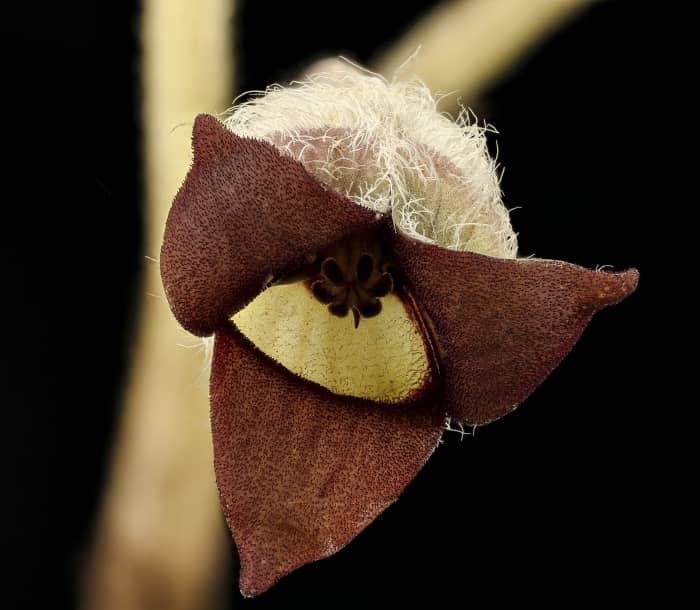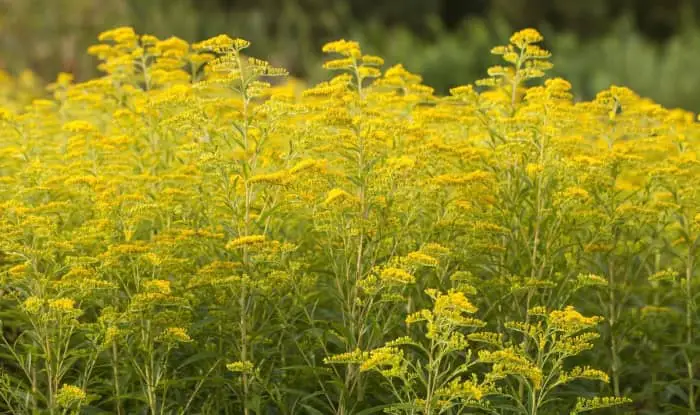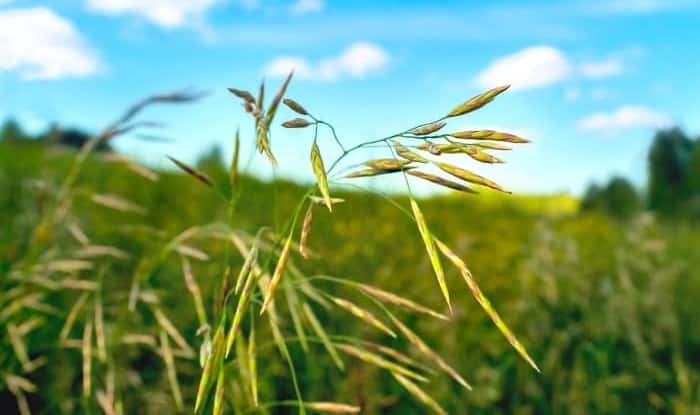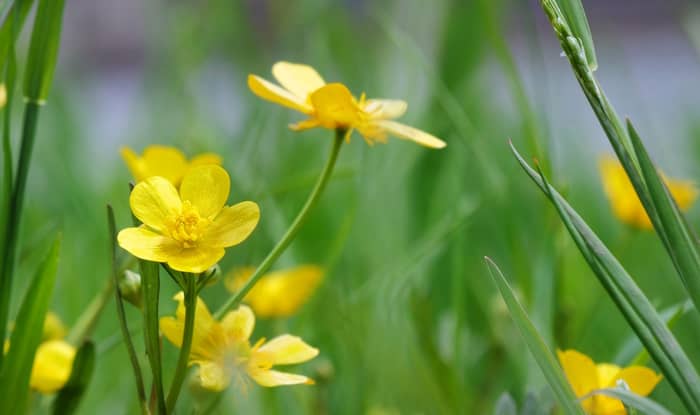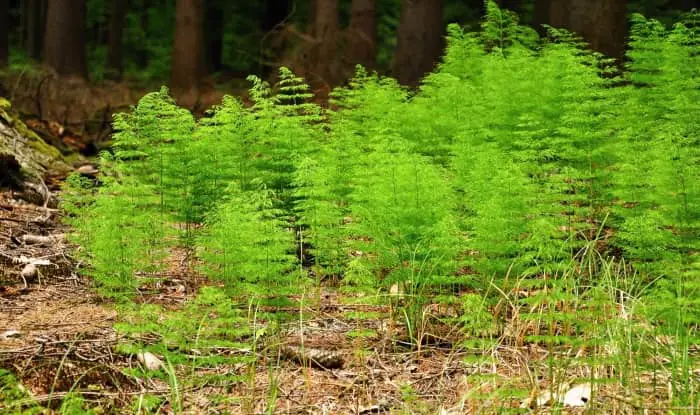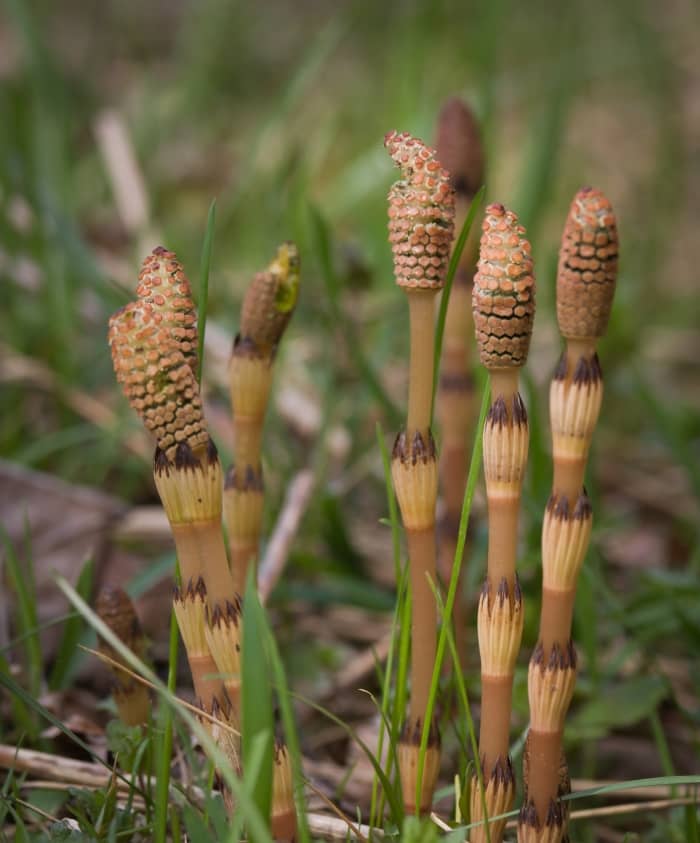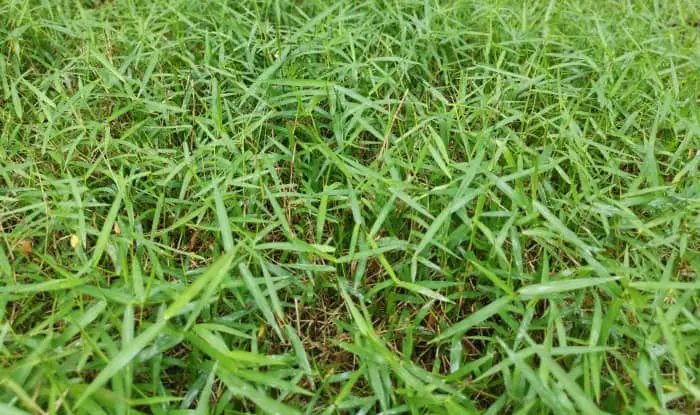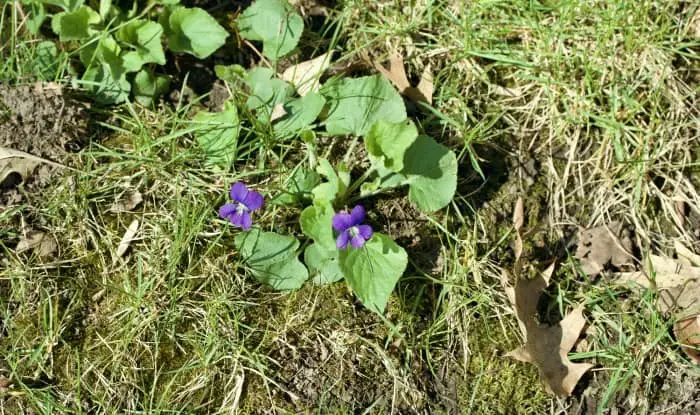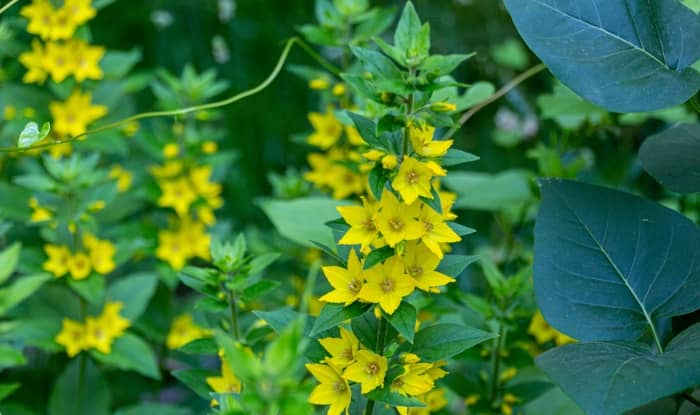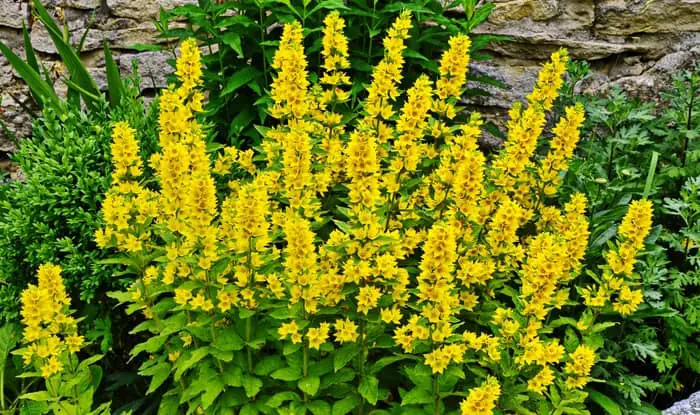Have you found some weeds with rhizomes growing in your yard?
We take a look at some of the most common types and help you identify them using photos and detailed descriptions. And we help you take steps to eradicate them.
Let’s dive in.
Weeds With Rhizomes
Also called creeping rootstalks, rhizomes are plant stems that usually grow underground and send out roots and shoots from their nodes. They often form part of an extensive root system and help weeds to spread.
Here are some common weeds with rhizomes to look out for:
Creeping Charlie (Glechoma hederacea)
Creeping Charlie, also known as ground ivy, is a common lawn weed with rhizomes that grows throughout much of the United States. Creeping Charlie prefers moist and shady areas, often growing in lawns, gardens, and landscapes. The weed grows in full sun but thrives best in partial shade.
Creeping Charlie can have a negative impact on the health of lawns and gardens, as it outcompetes other plants for resources like nutrients, water, and sunlight. In addition to spreading through runners, rhizomes, and seeds, it also has the ability to release chemicals that inhibit the growth of other plants in the area, a characteristic known as allelopathy.
The leaves of creeping Charlie have a distinct minty odor when crushed. This is due to essential oils, sometimes used in herbal teas and as a natural insect repellent. Despite its potential benefits, it is still considered a weed and can be hard to control if left unchecked.
One method of control is to regularly mow or trim the lawn to prevent creeping Charlie from producing flowers and setting seeds. Hand-pulling the weed can also be effective if done regularly and carefully, as any small pieces left behind can regrow. The use of herbicides can also be effective.
Japanese Knotweed (Fallopia Japonica)
Japanese knotweed is a notorious invasive weed, well-known for being one of the most troublesome and persistent weeds to have in your yard.
The broadleaf weed has a deep and extensive root system. The roots are tough and clump together, resembling wooden trunks that burrow deep underground. A network of rhizomes develops, from which new shoots emerge and quickly grow, adding up to 10cm per day, and reaching heights of up to 11ft.
You can identify Japanese knotweed by its red, hollow, and bamboo-like stem, while the large green leaves are heart-shaped with a pointed tip and can grow up to 7 inches long. In late summer, small white flowers that grow in clusters (panicles) appear.
Not only can Japanese knotweed rapidly grow, but it also causes structural damage to nearby buildings and penetrates through tarmac and paving. If the weed becomes established on your property, you might have to hire a professional to eradicate it.
Canadian Wild Ginger (Asarum canadense)
Wild ginger, also known as broad-leaved asarabacca and Canadian snakeroot, is native to eastern North America, typically growing in deciduous forests. However, this weed can also become established in your garden in the right conditions.
Wild ginger is a herbaceous perennial weed that thrives in shady areas, forming a dense groundcover of velvety heart-shaped leaves while spreading through rhizomes to form clumps that can quickly overtake an area. The rhizomes have an odor and flavor that resembles ginger.
The plant typically grows to a height of 4-8 inches and produces singular bell-shaped flowers that grow next to the ground, beneath the leaves. The leaves are hairy and brownish-purple.
Although wild ginger plants serve as a desirable groundcover for some people, preventing invasive weeds from becoming established in shady garden areas, they can also become unwelcome intruders.
It’s worth noting that wild ginger has a history of use as a medicinal herb by Native Americans. But you should avoid its use as it contains aristolochic acid, a known carcinogen.
Small clumps of wild ginger can be dug from the ground, as long as you remove all of the roots and rhizomes.
Couch Grass (Elymus repens)
This invasive grassy weed, commonly known as quackgrass, has a prolific underground rhizome growth, allowing it to spread rapidly throughout your lawn. The rhizomes have hard-pointed tips and are white or yellowish. The weed also reproduces through airborne seeds that can germinate in thinner lawns farther away.
Couch grass identification is relatively straightforward. It’s a tall grass that quickly forms large patches and has rougher and broader leaves than many common types of grass.
Maintaining a thick and healthy lawn is the best method to prevent couch grass from becoming established. If you spot the weed in your garden, digging it out can be challenging, as the roots break easily and can regrow from small fragments.
While weed killers are an option, most selective ones are ineffective, and non-selective weed killers can harm your lawn unless used with care. So carefully choose the right product.
Goldenrod (Solidago spp.)
Goldenrod is a wildflower often cultivated in gardens. But it can also be an invasive weed that spreads rapidly through seeds and rhizomes, forming large clumps that outcompete other plants in your yard. The rhizomes are 2-5 inches long and emerge at the base of aerial stems (1).
There are 60-70 species of goldenrod in the United States, all recognizable by their striking plumes of bright yellow flowers that bloom throughout the summer and into the fall.
Goldenrod thrives in full sunlight and well-drained soil, growing tall and slender, typically between 1.5-5 feet in height. Its long, green leaves grow alternately from the stem, contributing to its distinctive appearance.
Smooth Bromegrass (Bromus inermis L.)
Smooth bromegrass is a highly adaptable perennial weed that thrives in a range of conditions, including cold, heat, and drought. It favors deep, moist, well-drained soils, where it develops an extensive root system.
Growing between 15-30 inches tall, this plant produces numerous grass-like leaf blades with flat, smooth blades, and rough margins. The leaf blades have a distinctive W or M constriction about ⅔ of the way up.
Smooth bromegrass spreads through seeds and rhizomes and can quickly take over poorly maintained lawns, with the rhizomes forming an extensive sod (2). Keeping a thick, healthy lawn can crowd it out. And mowing it close to the ground can help control the weed since the plant is slow to recover from cutting.
Post-emergent systemic weed killers can stop the spread of smooth bromegrass by killing it all the way down to its roots.
Creeping Buttercup (Ranunculus repens)
You can easily identify creeping buttercup by its glossy, golden yellow flowers that grow at the end of a thin, green stalk, each with 5 petals. The weed grows up to 20 inches tall and features compound basal leaves with 3 lobed leaflets that can grow up to 8 cm long. Leaves higher on the stem are narrower, smaller, and often simple, and both leaves and stems have fine hairs.
While this weed can grow in various conditions, it thrives in poorly-drained soil, quickly infesting soggy areas of your lawn or garden. Creeping buttercup spreads by runners that root in the soil at the nodes, and it also has underground rhizomes that make it hard to pull the plant by hand.
The rhizomes help the weed to survive adverse conditions because even when the leaves die the plant can still sprout again several months later when the conditions improve.
Dealing with this weed before it spreads is crucial since the rhizomes and runners make it challenging to eradicate once established.
Field Horsetail (Equisetum arvense)
Horsetail, also sometimes called mare’s tail, is a primitive plant that has existed for over 300 million years. It is often called a “living fossil” due to its prehistoric origins. Horsetail has a unique structure that sets it apart from other plants. Its stem consists of segmented sections with small leaves growing in whorls around the stem.
You can find horsetail in many environments, including wetlands, forests, and meadows. It prefers to grow in damp, poorly drained soil and can even grow in standing water. The plant tolerates different soil conditions, from acidic to alkaline, and is resistant to many herbicides.
Despite being considered a weed, horsetail has several beneficial properties, leading to its medicinal use over the centuries as a natural diuretic, anti-inflammatory, and wound healer by many cultures.
However, the extensive root system and ability to spread quickly make horsetail a hard weed to control. The weed grows rhizomes up to 6 feet deep and 2-3 feet horizontally. The rhizomes are hairy, brown or black, and 3-5 mm in diameter. New shoots emerge through the soil from the network of rhizomes (3).
Horsetail is particularly problematic for farmers and gardeners, where it often quickly takes over large areas of land, competing with desirable crops or plants for nutrients and water.
Bermudagrass (Cynodon dactylon)
Bermudagrass is a versatile grass that can be used as a turfgrass or as forage for livestock. However, in some areas, it can also become an invasive weed.
This wiry perennial grass grows low to the ground and spreads through both runners (stolons) above ground and rhizomes underground. Both the runners and rhizomes can root in the soil, developing into new plants and making Bermudagrass difficult to control.
The grass leaves are smooth and pointed, with a unique ring of hairs where the blade and sheath meet. The upright flowering stems produce 3-7 spikes of clustered flowers at the terminal ends, with small purple to pink flowers that bloom in the summer.
Bermudagrass is a warm-season grass that thrives in hot and humid conditions. It has a high tolerance for drought and can survive in low soil fertility, making it difficult to control once established. The grass can quickly colonize open areas, out-competing other plant species, leading to reduced biodiversity.
In addition to its use as a turfgrass and forage, Bermudagrass is sometimes used for erosion control and as a cover crop. However, its invasive nature and rapid growth make it hard to manage. Weed control measures often include hand-pulling, herbicides, and regular mowing to prevent seed production.
Wild Violet (Viola sororia)
Wild violets are popular flowers in wild gardens because of their pretty, blue-purple blooms. They also have medicinal properties, traditionally used in tea for their calming effects and to relieve headaches and coughs.
But, while some people are happy to have wild violets growing in their yards, the plant quickly becomes a nuisance if it invades well-manicured lawns. Wild violets thrive in moist and shady environments when they are young, but as they mature, the weed spreads, taking over sunnier locations.
One way to identify wild violets is by their heart-shaped leaves with pointed tips and rounded teeth along the margins. The flowers usually have five petals and appear from April to June.
Violets propagate through seeds and short, thick rhizomes, making them difficult garden weeds to control.
To kill wild violets, you can use a broadleaf weed killer containing triclopyr, 2,4-D, dicamba, and MCPP. But the plant has a long emergence window between April and September, making multiple applications necessary. Pulling or digging up the plant by hand can be time-consuming and difficult.
Wild violets are beneficial to the ecosystem as their roots, seeds, and leaves provide a source of food for insects and wildlife. So, before removing them from your yard, consider the impact on the surrounding environment.
Garden Loosestrife (Lysimachia vulgaris)
Garden loosestrife, also known as yellow loosestrife, is a problematic invasive weed introduced to North America as an ornamental plant. The plant is now widespread across many parts of the United States, where it’s considered a noxious weed due to its aggressive growth and ability to outcompete and displace native vegetation.
Garden loosestrife is a tall weed that grows six feet or more, forming dense stands that spread rapidly and take over large areas. This weed blooms during the summer, producing striking primrose-like flowers that grow in clusters at the top of upright, hairy stems. The flowers have five petals and sepals and are yellow with orange-brown edges.
Garden loosestrife is known for its ability to spread quickly, both through seeds and rhizomes. The weed’s fibrous rhizomes create a dense mat underground, extending for up to 15 feet (4), making the plant challenging to remove once established. Garden loosestrife thrives in wet areas, and you’ll commonly find the weed in marshes, wetlands, and along the edges of ponds, streams, and lakes.
This invasive weed can cause significant ecological harm by displacing native vegetation and altering local ecosystems. Garden loosestrife can also have negative impacts on water quality and wildlife habitat. Therefore, you should take proactive measures to control and remove this weed before it spreads and causes further damage.
You can control garden loosestrife using several methods, including manual removal, cutting, or mowing the plant, and using herbicides. However, you should use herbicides cautiously, as they can harm non-target plant species and aquatic life. Preventing the spread of this weed can be achieved by avoiding planting it in gardens or disposing of plant material in a way that prevents seed dispersal.
References:
- Goldenrod (Solidago canadensis) – https://wiki.bugwood.org/HPIPM:Goldenrod
- Smooth Bromegrass – https://extension.missouri.edu/publications/g4672
- Field Horsetail – https://horticulture.oregonstate.edu/weed/field-horsetail
- Garden Loosestrife Identification And Control – https://kingcounty.gov/services/environment/animals-and-plants/noxious-weeds/weed-identification/garden-loosestrife.aspx

